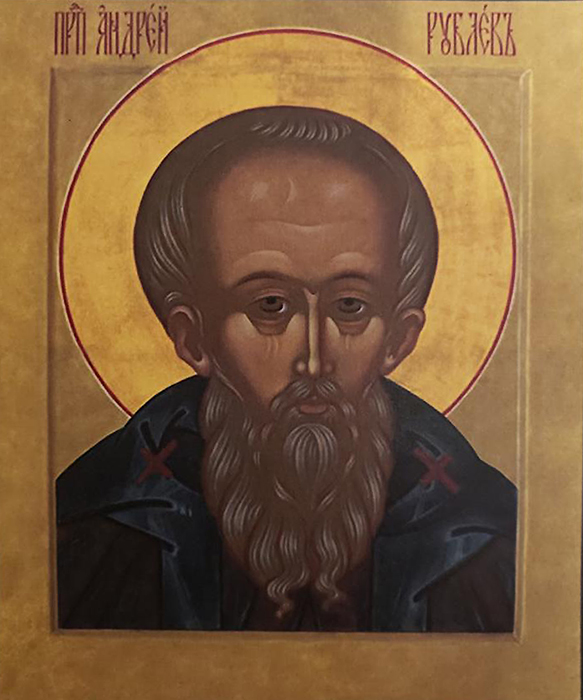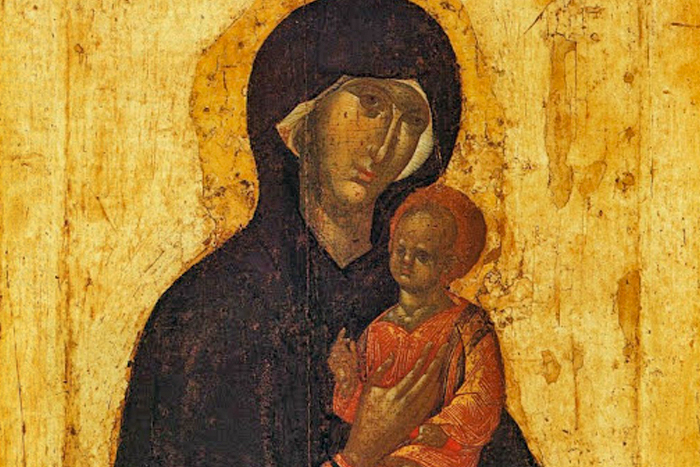
There is an opinion – I do not remember who expressed it – that people in the 15th century had such a thirst and need for God and that Andrei Rublev was able to write such an icon of the Holy Trinity, that a 15th-century Church synod issued a decree ordering all icon painters to portray the Holy Trinity the way Andrei Rublev had done.
At one point, children of Spanish Gypsies (who had no church or school education) were shown a reproduction of a Rublev icon and were asked to describe what they saw on it. The children described their impressions in different ways but they were unanimous in one thing: that the picture in front of them was an icon and that “when you look at it, you feel that it is looking back at you.”
Andrew Rublev lived and worked in a difficult period for Russia: on the one hand, it was a time of destruction and devastation after the foreign yoke, and on the other hand, Russia was having an unprecedented spiritual revival. The Russian religiosity of the 15th century sought to find an ideal, to see the images of heavenly beauty, to have the reminder that each person bears in himself the Image of God. The 15th-century icon painting combines the Russian tradition already established by that time with the themes of the wider Orthodox world, and the icons depict the ideal heavenly world, the heavenly bliss of the righteous, the kingdom of Grace.

There is very little data about Saint Andrei Rublev:
He was born ca. 1360 in the central region of Russia.
He studied and worked in a team of Moscow artists between 1370 and 1390s.
He took the vows with the name Andrew in 1405 and lived in the Andronikov Monastery of the Savior near Moscow.
He painted the Annunciation Cathedral of the Moscow Kremlin together with artists Theophanes the Greek and Prokhor from Gorodets in 1405.
The year 1408 saw him paint frescoes and icons in the Assumption Cathedral in Vladimir together with Daniil Cherny. Only one icon of the cathedral can be undeniably attributed to Andrei Rublev himself, namely a replica of the wonderworking Our Lady of Vladimir, which had been permanently stored in Moscow since 1395, and a full-size copy of which Vladimir needed. Circa 1408 he painted the icons that were later called the Zvenigorodsky Chin. Although there is no documentary evidence to support this fact, many art historians attribute these icons to the work of St. Andrei Rublev. The reason for this is the extremely high artistic quality of the Zvenigorodsky Chin and its stylistic features. Quiet contemplation prevails in the images: the slightly inclined heads, bright faces, light shades of blue – all this creates the impression of heavenly harmony and idyll.
Later (until 1427) he supervised the work on murals and the iconostasis of the Trinity Cathedral of the Holy Trinity St. Sergius Monastery together with Daniil Cherny. He painted the icon of the Trinity around the same time.
Between 1427 and 1430 he created the murals of the Holy Savior Cathedral of the Andronikov Monastery of the Savior.
He died on the 29th of January 1430 and was buried in the Andronikov Monastery of the Savior. According to another version, the date of his death is October 17, 1428.
Many icons and frescoes were attributed to St. Andrew Rublev, but many of them are considered by researchers to be the work of the school (the workshop) or contemporaries of the master.
The icon painter lived in the Holy Trinity St. Sergius Lavra for a certain period of time, and saw Saint Sergius of Radonezh, whose favorite disciple, Saint Nikon, later ordered the Holy Trinity from him. Andrei Rublev was brought up on living examples of ascetics who surrounded him.
The Trinity was painted as the main temple icon of the Trinity Cathedral of the Holy Trinity St. Sergius Monastery near Moscow. This icon is very revered and has been renewed many times. Its drawing and composition are mostly preserved, except for the angels’ heads – they were less protruded, and the hairstyles, which were less lush. This icon has another name, The Eternal Council, which refers to the mysterious communion within the Holy Trinity shown on the icon.
The Old Testament scene of a visit by three angelic messengers to the house of Abraham is depicted in a symbolic manner, without the figures of Abraham and Sarah. Andrei Rublev depicts three angels as a symbol of one being and the equality of the three persons of the Holy Trinity, which corresponds to the Orthodox Creed. This feeling of unity of the three angels is also achieved by the commonality of their state of mind, their quiet and light sorrow, and the distinct spatial arrangement of the figures. It is as if they form a circle inside which, if your eye follows the silhouettes, there is a slow, repetitive, endless movement.
If you look closely, the space between the knees of the side angels repeats the contours of the sacrificial cup, while the outline of the central figure is a reflection of this shape. An interesting fact is that the angels on the icon occupy three sides of the four-sided table, while the fourth one is vacant as if it includes a viewer, i. e. any of us.
There are different explanations and interpretations of the angels, but this is not really the main theme of the icon. Also important is the fact that the 1551 Stoglavy Sobor (lit. Synod of One Hundred Chapters) approved the Andrei Rublev icon as canonical, stressing that it does not depict the Divine Persons but rather the Holy Trinity. The Council also prohibited the inscriptions on the icon that indicate the Angels’ names, as well as the depiction of the “cruciform halo”, which could refer to Christ.
This icon combines theological depth with artistic perfection. It is in this icon that all the principles of Russian icon painting of the 15th century and its appeal to the person appear in their entirety for the first time. The Icon of the Trinity is the golden mean of harmony and excellence, an ultimate example of the icon that unveils the view of the divine world.




I enjoyed reading this brief article on St. Andrew Rublev, since so little on his life is a matter of record, especially in the English language! Thank you!
Dear John, you are so welcome! May God bless you!
This article had great commentary on my favorite icon. I never knew some of these facts. Great articles on your blog.
Dear Joseph, thank you very much! May God bless you!
Thank you. I adore this Icon. But did not know the artist behind it nor his times. May Rublev’s work evoke in us God’s presence